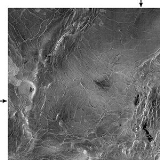
Baltis Vallis
Encyclopedia
Baltis Vallis is a sinuous channel on Venus
ranging from one to three kilometers wide and more than 7,000 kilometers long, slightly longer than the Nile
and the longest known channel of any kind in the solar system
. It is thought that it once held a river of lava
known as a lava channel
.
The channel is located in an area consisting entirely of plains and wrinkle ridges. The topography of the channel undulates, with some stretches travelling uphill, suggesting that various regions have uplifted and subsided since the channel formed.
Both ends of the channel are obscured, however, so its original length is unknown. The channel was initially discovered by the Soviet Venera 15 and 16
orbiters which, in spite of their one kilometer resolution, detected more than 1000 kilometres (621.4 mi) of the channel. These channel-like features are common on the plains of Venus. In some places they appear to have been formed by lava which may have melted or thermally eroded a path over the plains' surface. Most are 1 to 3 kilometers (0.6 to 2 miles) wide. They resemble terrestrial meandering rivers in some aspects, with meanders, cutoff bows and abandoned channel segments. However, Venus channels are not as tightly sinuous as terrestrial rivers. Most are partly buried by younger lava plains, making their sources difficult to identify. A few have vast radar-dark plains units associated with them, suggesting large flow volumes. These channels with large deposits appear to be older than other channel types, as they are crossed by fractures and wrinkle ridges, and are often buried by other volcanic materials. In addition, they appear to run both upslope and downslope, suggesting that the plains were warped by regional tectonism after channel formation.
Venus
Venus is the second planet from the Sun, orbiting it every 224.7 Earth days. The planet is named after Venus, the Roman goddess of love and beauty. After the Moon, it is the brightest natural object in the night sky, reaching an apparent magnitude of −4.6, bright enough to cast shadows...
ranging from one to three kilometers wide and more than 7,000 kilometers long, slightly longer than the Nile
Nile
The Nile is a major north-flowing river in North Africa, generally regarded as the longest river in the world. It is long. It runs through the ten countries of Sudan, South Sudan, Burundi, Rwanda, Democratic Republic of the Congo, Tanzania, Kenya, Ethiopia, Uganda and Egypt.The Nile has two major...
and the longest known channel of any kind in the solar system
Solar System
The Solar System consists of the Sun and the astronomical objects gravitationally bound in orbit around it, all of which formed from the collapse of a giant molecular cloud approximately 4.6 billion years ago. The vast majority of the system's mass is in the Sun...
. It is thought that it once held a river of lava
Lava
Lava refers both to molten rock expelled by a volcano during an eruption and the resulting rock after solidification and cooling. This molten rock is formed in the interior of some planets, including Earth, and some of their satellites. When first erupted from a volcanic vent, lava is a liquid at...
known as a lava channel
Lava channel
A lava channel is a stream of fluid lava contained within marginal zones of static lava or levees. The initial channel may not contain levees per se, until the parental flow solidifies over what develops into the channel and creates simple levees. This initial levee allows for the building of a...
.
The channel is located in an area consisting entirely of plains and wrinkle ridges. The topography of the channel undulates, with some stretches travelling uphill, suggesting that various regions have uplifted and subsided since the channel formed.
Both ends of the channel are obscured, however, so its original length is unknown. The channel was initially discovered by the Soviet Venera 15 and 16
Venera 15 and 16
Venera 4V-2 was a series of two identical spacecraft sent to Venus by the Soviet Union, consisting of Venera 15 and Venera 16. Both unmanned orbiters were to map the surface of Venus using high resolution imaging systems...
orbiters which, in spite of their one kilometer resolution, detected more than 1000 kilometres (621.4 mi) of the channel. These channel-like features are common on the plains of Venus. In some places they appear to have been formed by lava which may have melted or thermally eroded a path over the plains' surface. Most are 1 to 3 kilometers (0.6 to 2 miles) wide. They resemble terrestrial meandering rivers in some aspects, with meanders, cutoff bows and abandoned channel segments. However, Venus channels are not as tightly sinuous as terrestrial rivers. Most are partly buried by younger lava plains, making their sources difficult to identify. A few have vast radar-dark plains units associated with them, suggesting large flow volumes. These channels with large deposits appear to be older than other channel types, as they are crossed by fractures and wrinkle ridges, and are often buried by other volcanic materials. In addition, they appear to run both upslope and downslope, suggesting that the plains were warped by regional tectonism after channel formation.

